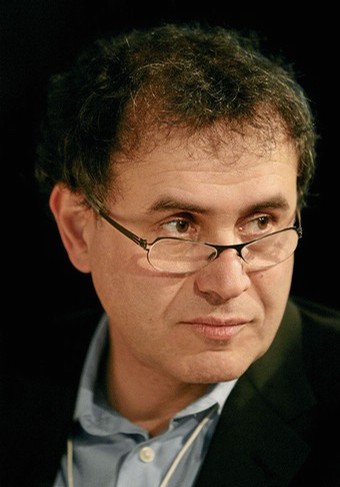Nouriel Roubini is a legitimate economic superstar who travels around the globe offering his view of the financial world to eager audiences. The Harvard-educated iconoclast is never shy about making bold predictions, and perhaps his most notable one was to predict the global credit collapse that began in 2007 and can still be felt all around us. His words carry a lot of weight in the financial markets and are often reported through various media outlets, and from time to time we discuss his statements on this blog. That being said, “Dr. Doom” may be losing some of his punch as we have observed his prognostications have become more docile as time has gone on.
The pressure to live up to a name like Dr. Doom may have weighed heavily on him since he was proven correct about the onset of credit crisis. Let’s take a look back at some of the more notable statements he has made recently to see if he has actually becoming a moderating influence on the market.
more notable statements he has made recently to see if he has actually becoming a moderating influence on the market.
November 2008 – Roubini warns that the financial crisis may be just beginning as there is a real potential for “Stag-deflation”, which would entail a stagnant economy and deflation. Clearly, that would be even worse that the Stagflation that the U.S. experienced during the 1970s. Further losses in the equity market would likely be unavoidable in such a scenario.
January 2009 – Roubini and his team at RGE Monitor estimated there could be $1.6 trillion worth of loan losses and another $2 trillion in mark-to-market losses of securitized assets, totaling in $3.6 trillion worth of damage to the capital markets thanks to the credit bubble’s burst. Banks and Broker Dealers would incur about half of those losses, which led him to conclude that the banking system was borderline insolvent. He argued financial institutions would need $1-$1.4 trillion of public or private investment to be adequately capitalized.
March 2009 – As the U.S stock market finally began to rebound, Roubini argued there could be at least another 20% of downside risk in the equity markets.
June 2009 – Roubini warns that the U.S. dollar is at risk of losing its status as the world’s reserve currency. He reasserted his belief that, “Recovery will be weak, anemic, subpar,” and advanced economies will grow at a slow rate after the recession.
July 2009 – The market rallies largely on Roubini’s comments from a speech in Istanbul, Turkey which were interpreted as bullish. He quickly refuted that analysis, and said his remarks were taken out of context. He reiterated his warning that the recovery will likely look W-shaped rather than V-shaped.
October 2009– Roubini remarked there may be a light at the end of the tunnel, and government efforts around the world have likely allowed a “bottoming-out”. That being said, politicians have little margin for error in monetary and fiscal policies matters to reverse course at the appropriate time. In addition to these comments, he still warned of the remaining possibility of the double dip.
Fast forward to today, Roubini spoke to a crowd in Hong Kong and although his comments could not be construed as bullish, there has clearly been a softening in language. According to Bloomberg, Roubini believes the ongoing rally in equities will likely see a correction in the second half of the year due to the threat of slower global growth and deflation fears.
A global rally in stocks may end in the second half of the year amid a muted recovery in the world’s largest economies and as deflationary pressures limit gains in corporate earnings, Nouriel Roubini said.
Failure to restrain asset-price bubbles in emerging markets, fueled by loose monetary policies in the U.S. and around the world, may also cause an “unraveling and a significant correction of asset prices which will be damaging to global and regional economic growth,” Roubini, the Harvard- schooled New York University professor who in 2006 foresaw the financial crisis, said in Hong Kong today. — Bloomberg.com 1/21/2010
In general, he thinks asset prices have advanced too far, too fast and are not supported by the fundamentals. That is not all that iconoclastic of an opinion, and shows just how far Roubini has come from predicting nothing short of global financial meltdown a year ago. Dr. Doom will probably never be a cheerleader for stocks or claim we are living in a goldilocks economy, but this is a substantial, if gradual, shift in his outlook.



